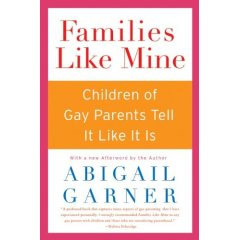Thinking Souls: Book Review: Families Like Mine
Shannon Gibney reads Abigail Garner's book collecting the experiences of children of gay and lesbian parents; the insights to be gained are many.


What happens when children of gay parents grow up? Do they simply assimilate into mainstream “straight” culture, adopting most of its attendant values and cultural forms? Assuming that they identify as straight themselves, do they abandon the queer community that many have thought of as “home” altogether?
First-time author and longtime GLBT activist Abigail Garner explores all of these questions and more in her book Families Like Mine: Children of Gay Parents Tell It Like It Is (HarperCollins, 2004). Although I’m sure that plenty of GLBT families will find Families Like Mine of interest, those who don’t come from such families will also find the questions Garner is posing about culture and identity both vital and fascinating.
One such fascinating tidbit is Garner’s use of the term “culturally queer, erotically straight.” Garner writes, “As more children talk openly about the gifts and challenges that come from their bicultural identities, they provide opportunities for queer communities to look at the impact of defining queerness as beyond ‘what you do in bed.’ Children who once wondered if they were being overly dramatic in their quest for belonging now know they are part of something bigger that validates previously unarticulated feelings. As Jon wrote when he first contacted me, ‘I finally know what the hell is ‘wrong’ with me. I am a culturally queer man trapped in a straight man’s body.”
Although, Garner points out, many children of LGBT parents come out as “second generation” queer, many more identify as straight. They have been raised in communities that celebrate various aspects of queer culture, and even derive a sense of belonging from their separation from mainstream heterosexual(ist) culture. As children of lesbians or gay men or transgendered individuals, they felt a sense of safety in spaces that they might not otherwise be welcome in. But what Garner argues, convincingly I believe, is that this strong tie to queer culture does not just fade away as children mature into adults. Many of the adult children Garner has talked to feel a profound sense of loss, and also often confusion, about being shut out of a community that they grew up thinking of as their own.
“Facing adulthood and ‘coming out’ as heterosexual does not mean children should have to relinquish ties to the LGBT community – the very community that has loved and nurtured them,” Garner writes. “If straight children have permission to maintain their sense of belonging, they can proudly carry the gifts of their queer heritage with them into adulthood. They need assurance that regardless of their sexual orientation, the community that raised them will always be their home.”
Garner also tackles the difficult topic of heterosexual pressure within the LGBT community – that is, the pressure that many children of LGBT parents feel to identify as straight, in order to prove that these parents can raise “normal” children. Living in a heterosexist and “homo-hostile” culture, Garner argues, creates a situation where parents always feel like they have to defend their decision to have, and raise kids. The media and American public are eagerly waiting to see how children of LGBTs “turn out.”
Garner quotes one adult child: “When queer parents want to highlight well-adjusted children to prove how normal our families are, ‘well adjusted’ is often a euphemism for ‘straight.’” Garner then shows how harmful this expectation can be to those “second generation” children who come out as gay. “These sons and daughters, already challenged by the usual stigma in broader society for being queer, face an added stigma within their own LGBT community from people who fear their visibility will enforce the stereotype. The history of homophobia shows why this fear exists, but it unfairly manifests into stigma that becomes the children’s burden. This stigma against queer kids of queer parents perpetuates a cycle of shame around queerness – a cycle of shame that LGBT communities need to be committed to eliminating on all levels.”
But Families Like Mine is not just about culture wars – it also contains much valuable information for queer parents who are wondering what their children are going through, and how best to handle it. A chapter on coming out examines the impact that this can have on children, by using case studies of adults who lived through the experience. Another chapter looks at how children can be supported through family break-ups and divorces, and yet another explores the impact of HIV/AIDS on children of gay parents. Garner leaves no stone unturned, and the result is a multifaceted and multi-layered meditation on the complicated politics of identity. The beauty of Families Like Mine, however, is that it both describes a nascent cultural phenomenon, and also prescribes various strategies for dealing with these new challenges. In this sense, it is definitely a book whose time has come.
For more information about Families Like Mine, or to find out more about the issues and/or connect with other LGBT families, visit Abigail Garner’s website, www.familieslikemine.com.